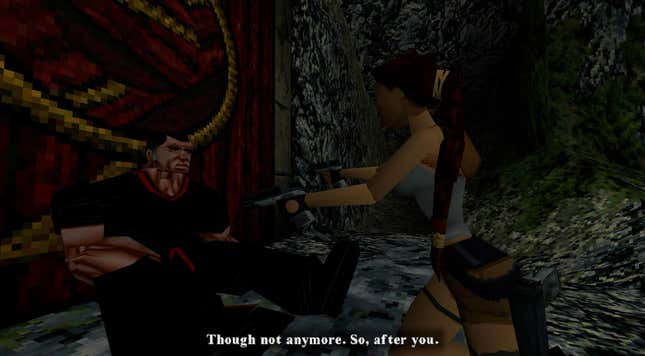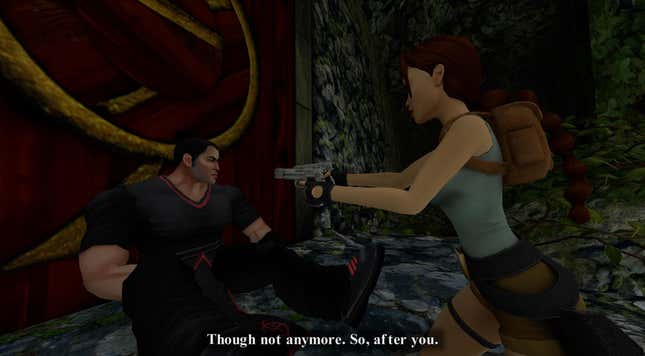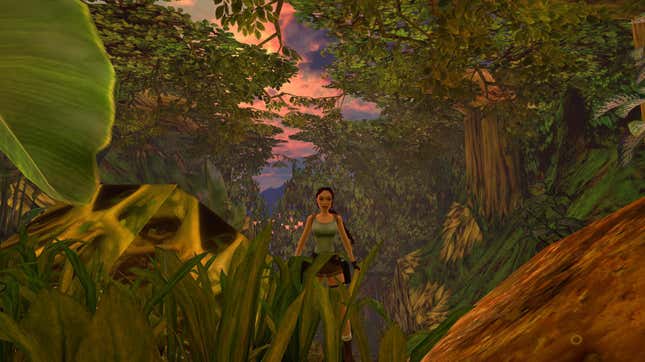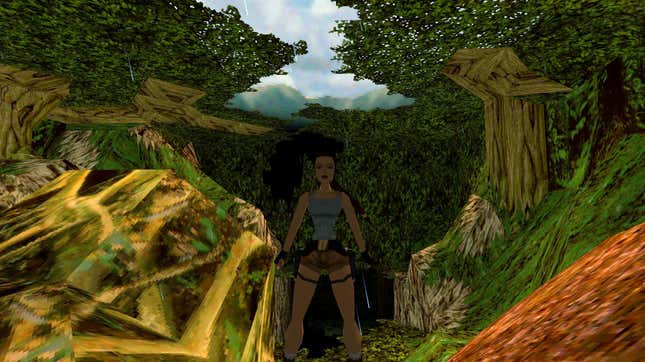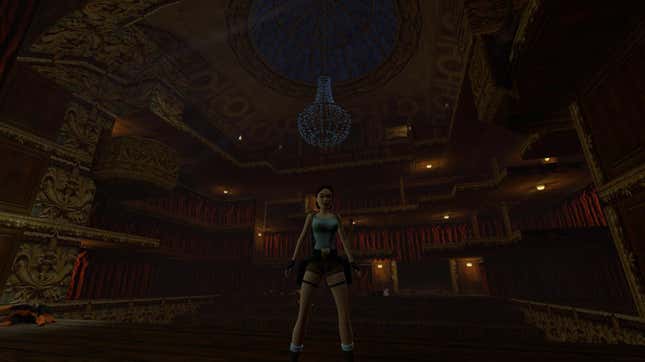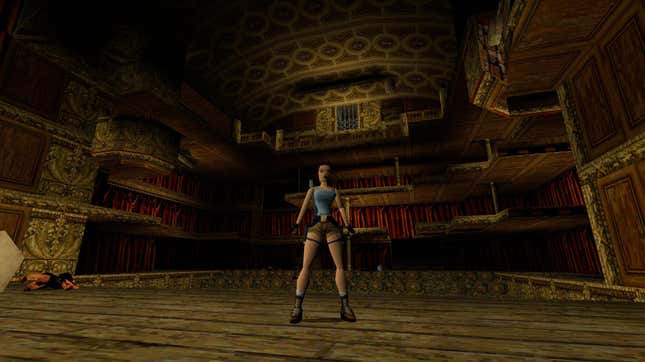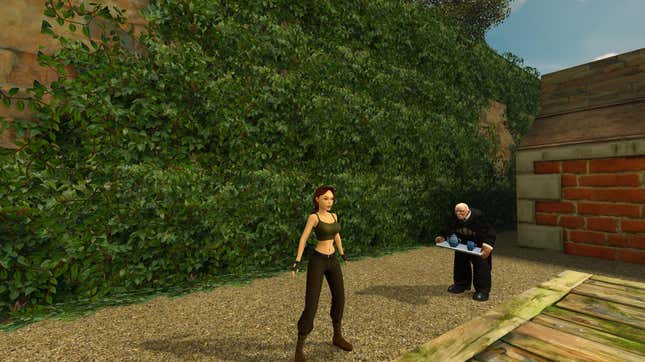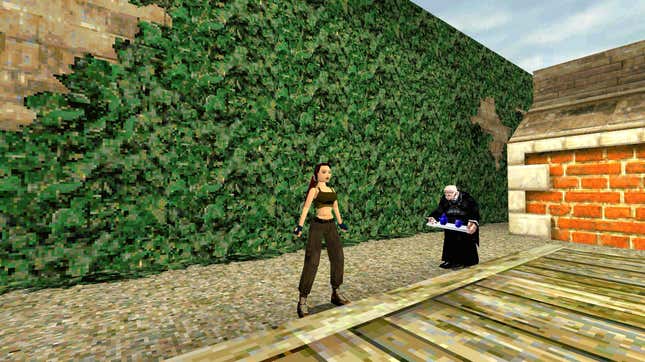How you define “remastered” means will certainly color your experience of playing Tomb Raider I-III Remastered Starring Lara Croft—the full, extraordinarily silly title of this collection. It’s an ambiguous word, and one that in gaming can mean anything from new packaging to remade from scratch. In the case of Ms. Croft and her first three adventures, the term should be defined as, “updated graphics, new controls,” and absolutely nothing else. And it doesn’t do either of those very well.
This collaboration between game restorers Aspyr Media, and whatever may remain of Crystal Dynamics after getting royally Embracered, is a remastering of games made by an entirely other team—Britain’s Core Design—in the latter half of the ‘90s. These iconic titles became a phenomenon, a massive part of gaming’s shift from a niche hobby to a mainstream pursuit, and sure sold a lot of PlayStations. Now, almost 30 years later, all three games are available to play again, with optional updated graphics, the choice to switch from the original tank controls to a more modern style, and…and…a photo mode? (You won’t want to use the photo mode. I couldn’t find the photo mode.)
Before we get into why this is such a colossal mess, there’s one extremely important aspect to set in stone: as a means of preserving these 1990s games, this remastering succeeds splendidly. You can now play the original three games on modern hardware, using modern controllers, and this is very definitely a Very Good Thing.
But this is also a remastering, with attempts to update the games for modern audiences, with an accompanying tripling of the price currently being charged for the original three games on PC. We need to judge it on this basis too.
These Tomb Raider remasters get off to a particularly inauspicious start. Before the game has even loaded, a self-flagellating splash screen informs you that the “depictions of people and cultures” in these games are “rooted in racial and ethnic prejudices,” which is “deeply harmful, inexcusable, and do not align with our values at Crystal Dynamics.” This does rather raise the question, if genuinely believed, then why are the studios putting such efforts into re-releasing these games? The message continues, “We have chosen to present it here in its original form in the hopes that we may acknowledge its harmful impact and learn from it.”

Oof. Yes, the reason that—when updating aspects of Tomb Raider such as the art, sound and controls—they felt it important to leave in the “harmful” and “inexcusable” prejudice is because they want you to jolly well learn your lesson. This is such a spectacularly disingenuous message, seemingly an attempt to gobble down the racist cake without either a) thinking better of it, or b) altering the content to better reflect these claimed values. I’ve checked, and none of the game’s marketing material mentions its woefully harmful content before you buy.
A cynic might surmise the developers don’t actually care at all, but thought this quick screen would cover their backs. Although—and let’s not mince words here—given Crystal Dynamics spent 2013 through 2018 making some of the most white-savior-promoting games in modern history, it’s hard to exactly pin down where these values lie. Yes, absolutely, flag up-front that the games feel dated and racist in their depictions of some cultures. But pretending that selling them unadjusted is a virtuous act on the developers’ part to offer us a vital and excoriating sociology lesson is gross and dishonest.
Anyway, past the first few seconds, you get to watch the original games’ cutscenes in their original quality, but now bigger. They obviously look awful, and it’s definitely a shame that new versions weren’t commissioned, but they sure make the updated version of the in-game graphics look like an improvement once they’re over.
Again, this isn’t a a remake. But it also doesn’t really feel like it qualifies as a refresh. It’s the original games cosplaying as something newer: smoother, but pretty ugly higher-res textures that look like they’ve been wallpapered over the original. This means that everything that was wrong with the original 1996 game remains equally wrong here, and given those games were wonky at the time—despite the wonderful level design and pioneering ideas—that’s a lot of stuff. The camera still helter-skelters around if you stand too close to a corner, or idiotically points at the ceiling when Lara walks near a ledge (and does so much worse when using the new controls). Lara still madly insists on a full on-the-spot jump animation if you’re a pixel too far away from the place where she will grab a ledge. The animations still look like you’re operating a tangled marionette. It’s just that now this all looks like it’s happening in a game made in 2006.
The thing about the original Tomb Raider games is they were less third-person action games, and more tile-based puzzlers. Movement required that you think in squares, lining Lara up with her back to a wall, ensuring she’d have one full tile of space to run before jumping across a gap. Climbing sequences were meticulous efforts in alignment, perfectly executed sideways jumps, and a lot of sliding back to the bottom. It was pretty frustrating in 1996, but given it was the birth of a genre, you learned to adjust to it, accepted these peculiar confines, or just didn’t play at all. In 2024, with three decades of advancements, it’s not nearly as easy to accept.
But there are now two ways to control the game! You can use the original 1990s “Tank Controls,” where Lara steers as if being pushed from behind like a shopping cart, meaning she’s forever veering off into walls or running off ledges. Or you can switch to “Modern Controls,” where you have more familiar third-person control and camera control on the right stick. The only problem is, these games weren’t designed for it, meaning she’s forever veering off into walls or running of ledges. It is quite spectacularly horrible to play with either method.
The result of trying to add more contemporary controls without fundamentally updating the game beneath them is disastrous. Lara’s previously clunky movement was at least designed to co-exist with her tile-based reality, but her attempts at direct movement just don’t fit. When attempting to achieve the games’ fiddly, tiresome precision leaps, she’s now far more likely to just run off the edge, and tiny nudges that would previously have turned her to face the correct direction now have her charge off to the side. It’s impossible to shake the feeling that there’s a combination of the two that would work. That you simply cannot sidestep or turn on the spot with the new controls—not even when holding down ‘walk’—beggars belief, given how vital each movement it is to so much of the game.
The tutorial obstacle course in Tomb Raider II exemplifies this perfectly, as Lara informs you that her sideways jump is ideal here, with a new set of controls that can’t do sideways jumps. It’s quite the thing.
Part of me wants to spend the rest of this week watching YouTubers trying to play these games for the first time, because it’s going to be hilarious. Not knowing that Lara requires one full tile of space to be able to do a running jump, especially now her new controls don’t move her around in tile-matching steps, is going to be a sight to behold, and they won’t have been trained to run up with her nose pressed on a wall, then roll to turn her around on the spot. And imagine trying to explain to anyone under the age of 35 that the correct way to get Lara to vertically jump to an overhead ledge is to just keep jumping up and down with her arms upstretched until she incrementally edges into the right position! Because, you still need to do that.
Playing on PC, I’ve experimented with every possible method I can think of to make these games enjoyable to play in 2024, and have failed. I thought at first the best bet was playing with the original tank controls, and using only the D-pad on my controller, to best simulate the original design, but three decades of iterative improvements to the action-adventure genre have had their effect on me too, and damn, it turns out it’s hard to go back.
In the end, bizarrely, I discovered the modern controls with mouse and keyboard is by far the easiest way to play, but must stress that even this is endlessly frustrating. I have spent so very much of the past few days tearing my hair in rage as Lara just runs sideways off a Venetian chandelier rather than turning slightly on the spot. Very much this mood:
Talking of playing on PC, it’s definitely worth noting this version doesn’t even bother to have video options. You’d imagine there’d be a range of ways to tweak or alter the updates, or take advantage of modern conceits, but there’s none of it. You can’t even adjust the resolution, so meager and dismissive is this port. You can, however, run it in a window and stretch it to any size you wish, which only demonstrates that the lack of options is a result of Aspyr/CD simply not bothering to add them.
So desultory is this refresh that it hasn’t even bothered to add in autosaves. Unless you judiciously manually save throughout levels (a habit surely all of us have gladly fallen out of), any single failure will see you sent back to the very beginning of the game. So you will get used to quick-saving before almost any significant jump (thank god on PC you can F5 to open up the save screen, rather than scramble through the awful UI), lest you repeat stretches of the game that already drove you to distraction. Or, you know, not bother.
Not bothering becomes so much more enticing when you remember that Crystal Dynamics already essentially remade the early Tomb Raider games, with its genuinely wonderful 2006 to 2008 trilogy of Legend, Anniversary and Underworld. These were made in the spirit of the early games, but with more up-to-date graphics, direct controls, and more modern sensibilities. But built from the ground up, intentionally. And they’re still there to play, old enough to induce nostalgia, but new enough not to feel like something painted on a cave wall.
For vital context, if you want to pick up these same three games with no updates at all, they’re available via GOG and Steam, and they work out of the box, no need for patches or mods, and all for a third of the price of this new bundle. And if you want to play 2006’s far more accessible, and utterly brilliant, Tomb Raider Legend, that too is available from all your favorite stores, and last week was on Steam for $1.
No matter all this griping, nothing should take away from the most important thing: that this preserves three vitally important games from gaming history—in their original form—for at least another few years. The new art and controls can be switched off, meaning you’ve got those classic games on your latest console, and that’s not to be sniffed at. Every other aspect, however: sniff away.
.

